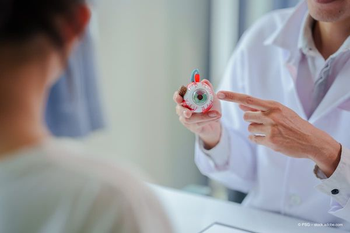
What makes pneumatic vitreolysis 'highly effective' for VMT
Treating symptomatic vitreomacular traction (VMT) with pneumatic vitreolysis and limited face-down positioning "is a highly effective emerging technique for achieving VMT release (86%) for focal VMT, with a respectable macular hole closure rate of 62%," said Calvin Mein, MD.
VMT is caused by an anomalous posterior vitreous separation with vitreous traction that distorts the foveal architecture, explained Dr. Mein, of Retinal Consultants of San Antonio.
Newer technologies, such as optical coherence tomography (OCT), have allowed clinicians to more readily and easily diagnose VMT. Under specific circumstances, tractional forces associated with progression of VMT may lead to the development of a full-thickness macular hole and further vision loss.
Management for symptomatic VMT includes observation, vitrectomy, and intravitreal injection of ocriplasmin, Dr. Mein said.
Concerns about the use of ocriplasmin and its potential side effects have led to pneumatic vitreolysis being suggested as an alternative.
About pneumatic vitreolysis
Pneumatic vitreolysis is an intravitreal injection of a small quantity of expansile gas for the purpose of achieving focal VMT release, or for inducing VMT release and the close of a macular defect for eyes with a small stage-2 macular hole, Dr. Mein said.
"We performed a retrospective study on patients with focal VMT who underwent PVL in 2 centers from 2010 to 2017," he said. "All patients were required to avoid supine position after receiving 0.3 mL C3F8 gas injection until gas resolution."
Among the exclusion criteria was previous retinal surgery (with the exception of prior ocriplasmin use) and any conditions deemed possible to confound the results (e.g., advanced cataract or advanced macular pathologic condition).
Patients with macular hole were asked to maintain face-down positioning for at least 4 days. Best spectacle-corrected visual acuity (BSCVA) was performed at baseline and at each follow-up visit, Dr. Mein said.
The surgical technique is an in-office procedure using subconjunctival anesthesia.
Dr. Mein creates an anterior chamber paracentesis, injects 0.3 cc of C3F8 at 12 o'clock. For patients with a macular hole, they must stay face down for 45 minutes every hour for the first 3 days postoperatively.
"These have to be motivated patients," he said. "Pneumatic vitreolysis has a CPT code-67025-almost as much as vitrectomy."
Study results
Sixty-nine consecutive eyes in 68 patients with VMT (47 women; mean age of 70.7 [range: 48-85]) underwent pneumatic vitreolysis; 42 of these patients had VMT only and 20 patients had small macular holes.
Overall VMT release was achieved in 59 eyes (85.5%) within a mean time to release of 2.9 weeks. Subgroup analysis showed VMT release in 79.2% of VMT-only eyes.
"That's why it's important to use C3F8 in these patients, because SF6 goes away sooner," he said, adding that SF6 "only works about half the time."
In eyes with macular holes, 61.9% of eyes closed with just using a gas bubble, Dr. Mein said.
All eyes with macular hold that failed to close with pneumatic vitreolysis were closed with surgery-pars plana vitrectomy, membranectomy, gas-fluid exchange, he said.
Median baseline and final BSCVA was 0.3979 ±0.213 and 0.24 ± 0.173 (20/50 and 20/35), respectively (p < 0.0001). For eyes with macular holes, baseline vision was 20/64, which improved to a final BSCVA of 20/33 (p = 0.001).
There were several characteristics predictive of success, Dr. Mein said, including a younger age, VMT size less than 1 disc diameter, and a lack of diabetes (although this was a small number). There was a trend toward cellophane maculopathy as a predictive characteristic, but it was not yet statistically significant (p = 0.077) and again, there were small numbers of patients.
The technique is not without complications, Dr. Mein said.
These included retinal tears in 2 eyes, retinal detachment in 2 eyes, and VMT progressing to macular hole in one eye; all responded to treatment. One eye developed unusual persistent loculated submacular fluid.
"There are several advantages of using pneumatic vitreolysis on small macular holes," Dr. Mein said, "including a low cost, it's office-based procedure, it does not induce cataract, and it does not require complex equipment."
But there are also downsides to the technique, including that it only works 60% of the time.
"Failures can be successfully managed and repaired by surgery," Dr. Mein said.
Dr. Mein described a case of a 68-year-old man with bilateral VMT and macular hole.
Dr. Mein performed pars plana vitrectomy with internal limiting membrane peel in one eye and pneumatic vitreolysis on the contralateral eye.
On optical coherence tomography, the eye that underwent pneumatic vitreolysis "looks like a completely healthy macula, with normal thickness," he said, with soft rounded edges, whereas the fellow eye had sharper edges.
Future studies will include the Diabetic Retinopathy Clinical Research (DRCR) Network's Protocol AG, a randomized clinical trial for VMT. The DRCR's Protocol AH will be a single arm study investigating pneumatic vitreolysis for small macular holes.
"At this point, intraocular injection of C3F8 gas alone with limited face-down positioning appears to be a viable alternative for treatment of symptomatic VMT and small stage-2 macular holes," he said.
Disclosures:
Dr. Mein is an investigator for Acucela, Alcon Laboratories, Allergan, the Diabetic Retinopathy Clinical Research Network, Iconic, and ORA. He reports other financial benefit from Genentech.
Newsletter
Keep your retina practice on the forefront—subscribe for expert analysis and emerging trends in retinal disease management.







































